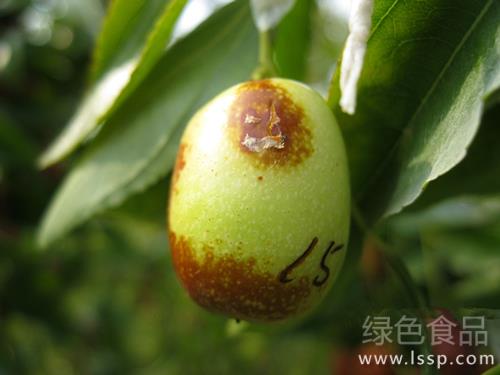Prevention and treatment of bitter pox disease of spongy apple with sunken pericarp
In apple production, due to different regions, climate, cultivation conditions, management and technical level, serious bitter pox disease will occur in some apple orchards, which will affect the fruit quality and cause losses to fruit growers. Now the editor discusses the etiology and control measures of apple acne disease, which can be used as a reference for fruit growers.

Bitter pox disease of apple
I. symptoms of the disease:
The root tip of the apple tree stops growing and the cortex is thick. In serious cases, there are new roots on the root tip, forming globular coarse roots; the growth of the top buds stops, the top leaves fade or grow necrotic spots, the leaf tip and leaf edge curl downward; the apple surface grows large, near-round sunken spots on the apple surface, cut open the diseased part of the flesh, the flesh turns brown, spongy, yellowish green apple, the diseased part epidermis is dark green, red apple, the diseased part epidermis is dark red, the browning flesh is deep 5~10mm, the diseased part flesh is bitter. In the later stage, the diseased part dried up, the epidermis was necrotic and browned, and the diseased spot was easy to attach other molds to cause rotten apple fruit.
Second, prevention and control measures:
1. Increase the application of organic fertilizer to improve soil environment. Organic fertilizer can be used crop straw, leaves, weeds, all kinds of feces, soil manure, green manure. Take measures such as inter-row recommendation, tree plate pressing grass, applying all kinds of feces, soil fertilizer and so on. The amount of organic fertilizer applied to apple trees in full fruit period is calculated according to chicken manure, not less than 3 cubic meters per mu. Through the above measures, the content of soil organic matter is gradually increased by 1% to 2%, so as to provide a good soil environment for apple trees.
two。 Balanced nutrition, non-antagonistic. Balanced fertilization and balanced nutrition make the content of nutrients in the soil meet the needs of apples, which not only increases the yield, but also does not antagonize each other. In general, the amount of pure nitrogen, phosphorus and potassium absorbed by large apple trees is 1.12 kg, 0.48 kg and 1 kg per 100 kg of apples, and 150 grams of other trace elements.
3. Calcium deficiency and calcium supplement, focus on adjustment. For apple orchards with bitter pox disease, the effect is obvious only if it needs special adjustment. Prevention and treatment of ① in growing period. Use calcium nitrate, calcium amino acid, etc. The amount of calcium nitrate was 40 kg / mu and 50 kg / mu in the full fruiting period. According to the law of calcium absorption of apples, the peak period of calcium demand is 3-6 weeks after flowering, accounting for 90% of the annual calcium demand. Before and after flowering, the apple was sprinkled with calcium nitrate, watered with a shallow hoe, and sprayed with 300-fold calcium amino acid three times after flowering. When the apple is nearly ripe (from late September to October), the peak of calcium demand should be sprayed twice with 300-fold amino acid calcium. Prevention and cure of ② during storage period. During storage, bathing apples with 600-fold potassium chloride aqueous solution can inhibit bitter pox disease in the later stage of storage. Through the adjustment of calcium supplement, the serious occurrence of acne disease in the apple orchard was basically controlled.
4. Reduce the load. Reducing the load can also reduce bitter pox. The yield per mu of trees in the full fruiting period is controlled at 2500-3500 kg.
5. Use less girdling to enhance calcium absorption. Girdling not only leads to the weakening of apple trees, the aggravation of rotten fruit disease, and the poor quality of fruits inside and outside, but also leads to the death of a large number of young roots (capillary roots) that absorb calcium fertilizer, and calcium can not be absorbed in the soil. Therefore, the apple trees entering the fruiting stage from peeling wide to narrow, from peeling to cutting, gradually do not need to peel around.
- Prev

Comprehensive control measures of jujube rotten fruit disease with soft jujube meat and wine, smelly mildew and sour taste
Comprehensive control measures of jujube rotten fruit disease with soft jujube meat and wine, smelly mildew and sour taste
- Next

Control measures of browning, moldy, softening and rotting zucchini brown rot
Control measures of browning, moldy, softening and rotting zucchini brown rot
Related
- Fuxing push coffee new agricultural production and marketing class: lack of small-scale processing plants
- Jujube rice field leisure farm deep ploughing Yilan for five years to create a space for organic food and play
- Nongyu Farm-A trial of organic papaya for brave women with advanced technology
- Four points for attention in the prevention and control of diseases and insect pests of edible fungi
- How to add nutrient solution to Edible Fungi
- Is there any good way to control edible fungus mites?
- Open Inoculation Technology of Edible Fungi
- Is there any clever way to use fertilizer for edible fungus in winter?
- What agents are used to kill the pathogens of edible fungi in the mushroom shed?
- Rapid drying of Edible Fungi

